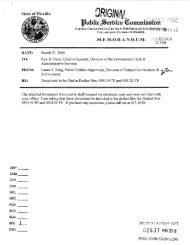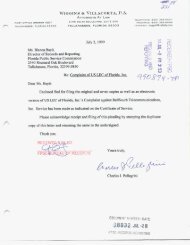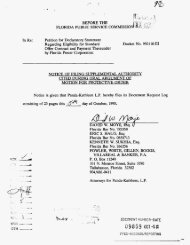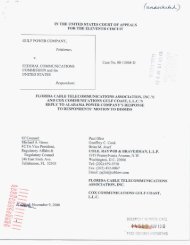2 - Public Service Commission
2 - Public Service Commission
2 - Public Service Commission
You also want an ePaper? Increase the reach of your titles
YUMPU automatically turns print PDFs into web optimized ePapers that Google loves.
ORDER NO. PSC-08-0846-FOF-WS<br />
DOCKETNO. 080006-WS<br />
PAGE 8<br />
Docket Nos. 090445-WS .s 090459-ws<br />
Utilities Grove Land and Bluefield<br />
Wtness: Hartrnan<br />
Exhibit GCH-2 Page 8 of 37<br />
to appropriately recognize this incremental difference in risk between the companies in the<br />
natural gas index and the average WAW utility in Florida, witness Rothschild’s recommended<br />
leverage formula produces results that understate the required return for these utilities. For these<br />
reasons, we find it appropriate to continue to make a bond yield differential adjustment as<br />
reflected in Attachment A to this Order.<br />
Private Placement Premium Adjustment<br />
OPC witness Rothschild testifies that there are a sufficient number of investors, such as<br />
retirement funds and life insurance companies, that plan to hold an investment to maturity and<br />
have no reason to expect a private placement premium. Witness Rothschild states that he<br />
attempted to find studies that evaluated the cost difference between private placement and public<br />
placement debt. The only study he said he was able to find was a working paper entitled<br />
“Financial Contracting and the Choice between Private Placement and <strong>Public</strong>ly Offered Bonds,”<br />
dated November, 2004, by Simon H. Kwan of the Economic Research Department of the Federal<br />
Reserve Bank of San Francisco and Willard T. Carleton of the Department of Finance at the<br />
University of Arizona. The authors concluded:<br />
Finally, we find evidence that borrowers self-select their debt issuance choice to<br />
minimize financing costs. However, switchers that issue debt in both markets do<br />
not realize significant cost savings by issuing bonds in the private market.<br />
Witness Rothschild believes this shows that the private placement alternative is selected when<br />
the borrower perceives an opportunity to experience a lower cost of debt rather than as a<br />
mechanism for higher cost.<br />
UI witness Ahern testifies that it is appropriate to include a private placement premium in<br />
the cost of common equity calculation in the leverage formula because investors demand<br />
compensation for the lack of liquidity experienced with this type of debt relative to large, readily<br />
saleable publicly traded debt. She states that privately placed debt is typically held to maturity<br />
and does not, by definition, have a public market in which it is traded. This leads witness Ahem<br />
to believe that holders of privately placed debt require a higher return than holders of publicly<br />
held debt, and that this higher return premium must be reflected in the common equity cost rate.<br />
We agree with witness Rothschild that companies that have access to both publicly and<br />
privately placed debt may not realize significant cost savings between the two forms of<br />
financing. However, witness Rothschild failed to demonstrate that the average Florida WAW<br />
utility is capable of accessing both public and private financing. Witness Rotbschild, when<br />
asked whether he could identify any WAW utility under our jurisdiction that has issued equity<br />
through private placement, stated that he had not studied the issue. He also admitted that he did<br />
not specifically study the small WAW utilities in Florida to which the leverage formula is<br />
legislatively mandated to apply. In addition, we find that the average WAW utility in Florida<br />
does not have access to public financing. The fact that an average WAW utility in Florida<br />
cannot access public financing justifies the inclusion of a private placement premium adjustment<br />
to compensate for the lack of liquidity and the higher cost of financing of privately placed debt.












